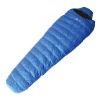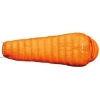Down sleeping bags Size: 200+30x80x55cm Shell: pretex nylon Lining: polycotton Filing:1000 g 90% groose down
1 | Description | Down Mymmy Sleeping Bag |
2 | Model :NO. | SWCS103-ENV |
3 | Overall Size | 230 x 80 x 55 cm |
4 | Shell | Pretex nylon |
5 | Lining | Polycotton |
6 | Filling | 1000g 90% groose Down |
7 | Extreme temperature | /-20°C |
8 | Packing Size | 44 x 45 x 88 cm / 8pcs |
9 | G.W./N.W. | 11/10KG |
10 | Q'TY/ 20' GP | 1,260pcs |
11 | Q'TY/ 40' GP | 2,617pcs |
12 | Q'TY/ 40' HQ | 3,066pcs |
13 | OEM:customer design and logo available | |
14 | High quality with competitive price,we offer credit for any defective parts form our goods | |
Here's how to choose the right one, and some tips for its care and cleaning
The most important component of camping gear is the sleeping bag. A well-chosen bag will fit the person using it, be easy to pack, store and care for, and suit the temperature it's being used for
• SIZE
Who will be using it? An average sized person can fit comfortably inside most sleeping bags, but a small or a very large person needs to actually crawl inside one to be sure that it's long enough and wide enough for comfort and small enough to retain warmth
A well-fitting bag will allow room to turn over and move around a little bit, but will not have so much air space that body heat won't warm it sufficiently
A short person or a child might be able to get by with a normal sized sleeping bag by tying off the lower portion with twine or camping straps
• SHAPE
Sleeping bags come in either a rectangle, mummy or tapered shape, narrower at the bottom. The rectangular ones have more room to move around in. Generally, they are the least expensive and easiest to zip together to make a double bag for two people, but they are also the bulkiest and heaviest
Mummy bags tend to be warmer because there is less space to heat. They also take up less room in a stuff bag and are the most heat-efficient
Tapered bags fall between the two, also called Hybrid and semi-rectangular combine mummy bags with rectangular bags. They can be zipped to others with matching zippers, take less body heat to warm them than rectangular ones, and allow some room for foot movement
• FABRIC
Shell
The shell is what the outside of the sleeping bag is made of. Shell materials have different qualities and come in a wide variety of materials. If you plan to canoe camp, camp in damp regions during the winter, a water resistant shell made of microfiber,etc. If you are interested in saving some money, or will be doing more general camping, taffeta, nylon, or polyester may be a better choice. If you are looking for a sleeping bag to take up the cabin on the weekends, then a simple cotton shell may meet your needs
Lining
The lining is the inside of the bag or the part that you actually lay on. Like the shell, linings come in a number of materials. Lining materials can include silk, taffeta, nylon, polyester, cotton, or fleece. When selecting a lining consider your personal comforts. Do you wake up in the middle of the night and flip your pillow over simply because it is warm? Then fleece or nylon may not be the best choices. Silk is wonderful but very expensive and rips easily. Cotton is comfortable and inexpensive, but it is not very durable
Fill
Fill is what the sleeping bag is stuffed with. The fill is what keeps you warm. Fill comes in basically two types of materials, natural down, typically goose feathers, and synthetic or man made fibers. Pound for pound nothing will keep you warmer than down. However down is more expensive than man made material and if it gets damp, looses almost all of its ability to keep you warm
• FEATURES AND OPTIONS
Zippers:
You may see sleeping bags that come as left zip or right zip. There is no real major advantage to one or the other. If you have a left zip and a right zip bag, you can typically zip the two together. If you are a left-handed person in a right-handed world, a left zip sleeping bag might be easier for you to operate in the dark
Hood:
Rule number one in staying warm, 50% of your body’s heat loss is through your head. Unless you plan to only do summer camping, a sleeping bag with a hood is a must have option. Hoods come in a variety of styles. Some hoods are simply made of the shell material and stretch around your head. Others may have drawstrings so you can cuddle up until just your face is coming through. Others may be insulated and offer other features to help keep the rest of you warm
Pocket:
Some sleeping bags have zippered pockets or flaps on the outside of them. These are handy for keeping things that are important close to you like eyeglasses, or your watch,etc.(if you don’t sleep with it on)
Compression Sack/Storage Bag:
A storage bag helps protect your sleeping bag when it is not being used. Usually made of a breathable material these bags allow you to pack your bag so that it is loose and this helps your loft maintain it’s fill. A compression sack is usually made of a more durable, moisture resistant material. This is a special bag that allows you to squeeze down your bag, taking up less room in your pack. Compression sacks are very important when hiking out in the backcountry but are not the best way to store your bag. Long-term storage of a sleeping bag in a compression sack can make it loose its loft
Draft Collar:
A draft collar is usually found on mummy bags with hoods. This insulated collar fits around your neck as you sleep. Warm air stays in the bag, and cold air as you move around during the night stays out
Zipper Draft Tube/Insulated Zipper:
Usually hanging down over the zipper (which helps it stay in place) this baggy area over the zipper helps keep your body warmth in while keeping drafts through the zipper out
• CARE & STORAGE
Always open the bag after a night of sleeping in it to air it out. If it's not raining or damp out, spread it across the top of your tent or car for freshening
mummy sleeping bag












